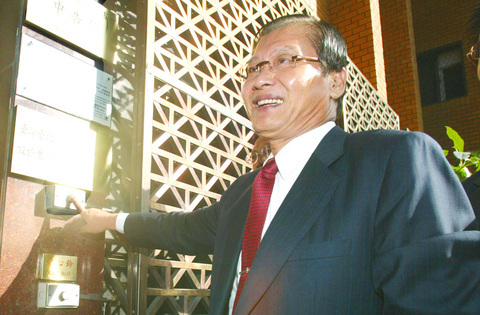The People First Party (PFP) caucus yesterday proposed amending the law to empower lawmakers to exercise the right of investigation, including summoning the president, in order to probe the Kaohsiung Rapid Transit Corp (KRTC) scandal.
PFP caucus whip Hwang Yih-jiau (黃義交) said the caucus plans to file a motion during the Nov. 8 session to amend the Law Governing Legislators' Exercise of Power (立法院職權行使法) and push the amendment through to a second reading.
Hwang said the caucus has obtained the consent of Legislative Speaker Wang Jin-pyng (王金平) and endorsement of the Chinese Nationalist Party (KMT) caucus to forge ahead with the proposal.

PHOTO: CNA
The recent wave of scandals surrounding President Chen Shui-bian's (
Both the president and former Presidential Office deputy secretary-general Chen Che-nan (陳哲男) could be called to the legislature for questioning about their roles in the KRTC scandal after the amendment passes, Hwang said.
In response, the pan-green caucuses called on the PFP to support the confirmation of the president's Control Yuan nominees.
Democratic Progressive Party (DPP) caucus whip Jao Yung-ching (
Although lawmakers have the power to summon civil servants and question them during the process of legislation or budget review, Jao said they must not abuse the right by trying to usurp the role of prosecutors.
DPP Legislator Gao Jyh-peng (
Taiwan Solidarity Union (TSU) caucus whip David Huang (
Another TSU caucus whip, Legislator Kuo Lin-yung (郭林勇), said that although the Council of Grand Justices has ruled that lawmakers are entitled to exercise the right of investigation, it also ruled that such a practice must not violate the principle of separation of powers among branches of government.
Meanwhile, in response to media reports that Chen Che-nan and Chen Min-hsien (陳敏賢), former KRTC vice chairman were spotted sitting together at a casino table in a Seoul hotel on Nov. 2, 2002, the Presidential Office said it had no record of Chen Che-nan having asked for leave or traveling overseas in November 2002.
There had also never been any "inspection report on the foreign labor situation" allegedly presented to the president by Chen Che-nan, said Chen Wen-tsung (
Chen Min-hsien said yesterday that he and Chen Che-nan did tour South Korea's Cheju Island in November 2002. He said the recent media reports only prove that the two men were "enjoying a legal recreational activity."
"Chen Che-nan and I are good friends. We went to a recreational area, purely for tourism. It's nothing. It has nothing to do with the KRTC scandal," he said.
Chen Che-nan issued a statement to the press last night admitting that he had made a trip to South Korea at the time in question. He apologized for visiting Cheju on a working day without notifying his superiors, but he reiterated that he was not involved in the KRTC scandal.
KMT Chairman Ma Ying-jeou (馬英九) said yesterday that he "was not surprised at all" by the new evidence that has come out after the Kaohsiung City Government released its investigation report on the scandal.
He said the opposition parties hope there won't be any obstacles to future's investigations by prosecutors and courts.
In a related development, Chao Yu-chu (
Chiu has claimed that Chen Che-nan went to Thailand in November last year with a "retired school principal who is closely related to the Presidential Office" and that the principal is an "influential figure" in the KRTC scandal.
Chao Yu-chu is a retired principal.
Additional reporting by Mo Yan-chih

A strong continental cold air mass is to bring pollutants to Taiwan from tomorrow, the Ministry of Environment said today, as it issued an “orange” air quality alert for most of the country. All of Taiwan except for Hualien and Taitung counties is to be under an “orange” air quality alert tomorrow, indicating air quality that is unhealthy for sensitive groups. In China, areas from Shandong to Shanghai have been enveloped in haze since Saturday, the ministry said in a news release. Yesterday, hourly concentrations of PM2.5 in these areas ranged from 65 to 160 micrograms per cubic meter (mg/m³), and pollutants were

Taiwan’s armed forces have established response protocols for a wide range of sudden contingencies, including the “Wan Chun Plan” to protect the head of state, the Ministry of Defense (MND) said today. After US President Donald Trump on Saturday launched a series of airstrikes in Venezuela and kidnapped Venezuelan President Nicolas Maduro, concerns have been raised as to whether China would launch a similar “decapitation strike” on Taiwan. The armed forces regularly coordinate with relevant agencies and practice drills to ensure preparedness for a wide range of scenarios, Vice Minister of National Defense Hsu Szu-chien (徐斯儉) told reporters before a

EVA Airways on Saturday said that it had suspended a pilot and opened an investigation after he allegedly lost his temper and punched the first officer several times as their plane was taxiing before takeoff at Los Angeles International Airport. According to a report published on Thursday by The Reporter, the incident occurred after the flight’s Malaysian first officer tried to warn the Taiwanese pilot, surnamed Wen (文), that he was taxiing faster than the speed limit of 30 knots (55.6kph). After alerting the pilot several times without response, the first officer manually applied the brakes in accordance with standard operating

The New Taipei City Social Welfare Department on Thursday celebrated Paralympic competitor Chen Tzu-wei (張孜維), who received last year’s national Golden Eagle award for exemplary achievement by Taiwanese with disabilities. Chen, who suffers from childhood-onset muscular dystrophy, did not attend the first award ceremony held by the Ministry of Health and Welfare in November due to illness. Chen was formally presented with the award at the department, where he gave thanks to government workers for supporting his education and livelihood, the department said in a statement. Chen was raised by the Ai-hsin Home for Persons with Disabilities in the city’s Bali District (八里)